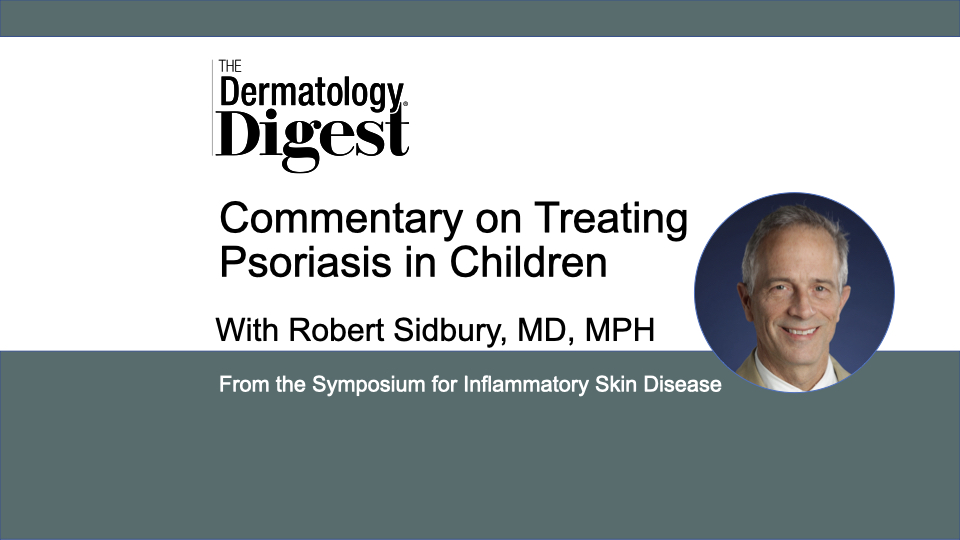Dr. Robert Sidbury discusses the nuances of diagnosing and treating pediatric psoriasis.
Robert Sidbury, MD, MPH, is Professor of Pediatrics and Chief of Dermatology, Seattle Children’s Hospital, University of Washington School of Medicine, Seattle, Washington
“Psoriasis is often thought of as an adult disease. But kids definitely get psoriasis, and kids can get psoriasis sometimes in ways that can easily be mistaken for other things,” said Robert Sidbury, MD, MPH, who presented “Treating Psoriasis in Children,” during the virtual Symposium for Inflammatory Skin Disease meeting.
Dermatologists might diagnose psoriasis in adults often, but if they don’t see many children, they might not know how psoriasis can present differently in kids, said Dr. Sidbury.
“There is a version of psoriasis that we call napkin psoriasis, because ‘across the pond,’ they call diapers napkins. Napkin psoriasis is just diaper psoriasis. But if you see a baby with a red rash in the diaper and you’re accustomed to thinking about things that cause diaper rash in kids, psoriasis may not come up if you don’t see a lot of kids because the classic morphology of psoriasis has a very clear silvery scale. It’s quite striking in most cases. But, in areas where it’s constantly moist like the diaper area, that scale is gone. All you see is a well demarcated rash.”
“So, for providers who don’t see a lot of kids or very young kids, just keep psoriasis in your differential for really any diaper dermatitis that is not responding to, perhaps, your first thought and intervention.”
Systemic Treatments Improve
Biologic therapies for pediatric psoriasis have been available for years and biologic options continue to grow at a fast pace, said Dr. Sidbury.
“The really nice thing that we’ve been seeing is the biologics for psoriasis have become increasingly effective. …efficacy seems to get better and better, while the safety has either stayed the same or gotten better, so we’re not really sacrificing anything with these new medications and gaining a lot.”
While dermatologists and other providers still use tumor necrosis factor (TNF) inhibitors, there are lots of new systemic options, he said.
“The very first one that was approved for psoriasis was etanercept (Enbrel, Amgen). Then we started to get others and now we have several different biologics approved down to either 4 years or 6 years of age—things like ustekinumab (Stelara, Janssen Biotech) and the new interleukin- (IL)-17 inhibitors like secukinumab (Cosentyx, Novartis) and ixekizumab (Taltz, Lilly).”
These options also are becoming more kid-friendly, said Dr. Sidbury.
“From a pediatric perspective, it may seem trivial to some but to kids it’s anything but—it’s ‘How many shots am I going to get?’”
That has gone from one a week with etanercept, to one every other week with medications like adalimumab (Humira, Abbvie) to the newer IL-17s, which are generally once a month. Now, with ustekinumab, it’s 4 shots a year, he said.
“When you start talking about those things with kids, that matters. It shouldn’t be the only thing, and it isn’t, but it’s definitely part of the discussion we have with our pediatric patients, especially if you’re not losing anything otherwise and may be gaining.”
Prescribing Considerations
How does a dermatologist decide to recommend a systemic medicine for pediatric psoriasis?
According to Dr. Sidbury, body surface area is a part of an overall assessment of severity. Generally, psoriasis that covers more than 10% of body surface area would be considered severe and 3% to 10% moderate.
But that’s only one consideration, he said.
“I think anywhere in that range, you’re at least thinking about [systemic treatment]. Now if a patient with 10% body surface area responds to a safe, sustainable topical regimen, well I don’t care about what the body surface area is and will probably argue for topical therapy.”
On the other hand, if a patient has milder disease in more sensitive, visible areas (the face or hands) and isn’t responding to a topical, systemic treatment may be a better option, he said.
“Regardless of the quantitative assessment of severity, if that patient’s quality of life is impacted negatively and his therapy isn’t moving that needle, then it’s not inappropriate to consider systemic therapy.”
According to Dr. Sidbury, he considers severity, quality of life, and what patients have tried and failed in the past. The last consideration is important for coverage of these expensive medications.
Psoriasis comorbidities might also affect the decision to use systemic therapies in pediatric patients, said Dr. Sidbury.
“Children tend to get less psoriatic arthritis. What we don’t know is whether one of the most striking comorbidities—the cardiovascular impact of psoriasis in adults—also happens in children.”
Some studies suggest that atherosclerotic changes seen in adults with psoriasis also occur in children, earlier than previously thought, he said.
“That begs the question, when we’re making that decision about the appropriateness of systemic therapy and have severity, quality of life, and refractory disease, should we factor in whether we could prevent heart disease when a patient is 60 years old by treating them more aggressively now? I don’t think that question is settled, but it’s very much open for debate and being studied.”
Disclosures: Through his institution, Dr. Sidbury has been an investigator for Regeneron, UCB and Galderma. He is on the speakers’ bureau for Beiersdorf and has been a consultant for Leo Pharma.


